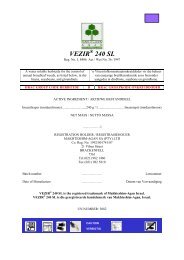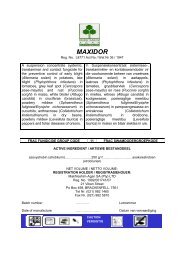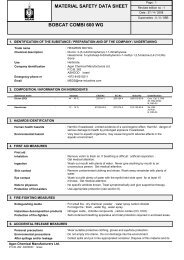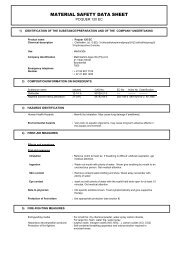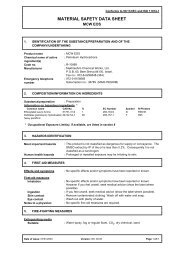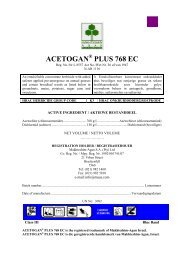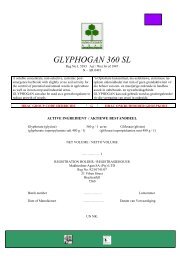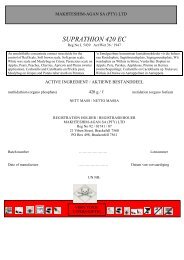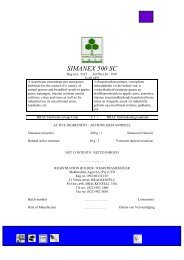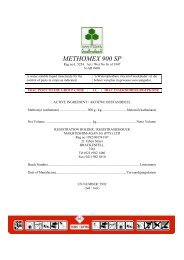SUPRANEX 600 SC MAKHTESHIM-AGAN SA (PTY) LTD
SUPRANEX 600 SC MAKHTESHIM-AGAN SA (PTY) LTD
SUPRANEX 600 SC MAKHTESHIM-AGAN SA (PTY) LTD
Create successful ePaper yourself
Turn your PDF publications into a flip-book with our unique Google optimized e-Paper software.
A suspension concentrate herbicide for the control of<br />
annual broadleaf weeds as well as goosegrass in maize<br />
and grainsorghum.<br />
<strong>MAKHTESHIM</strong>-<strong>AGAN</strong> <strong>SA</strong> (<strong>PTY</strong>) <strong>LTD</strong><br />
<strong>SUPRANEX</strong> <strong>600</strong> <strong>SC</strong><br />
Reg No L 5351 Act / Wet 36 of 1947<br />
N – AR 0494<br />
‘n Suspensiekonsentraat onkruiddoder vir die beheer van<br />
eenjarige breëblaaronkruide asook jongosgras in mielies<br />
en graansorghum.<br />
ACTIVE INGREDIENTS/ AKTIEWE BESTANDDELE<br />
Atrazine (triazine) 291 g / l Atrasien (triasien)<br />
Terbuthylazine (triazine) 291 g / l Terbutielasien (triasien)<br />
Other active triazines 18 g / l Ander aktiewe triasiene<br />
NET VOLUME / NETTO VOLUME<br />
…………… l<br />
REGISTRATION HOLDER / REGISTRASIEHOUER<br />
Makhteshim-Agan <strong>SA</strong> (Pty) <strong>LTD</strong><br />
Reg No. 92/01741/07<br />
21 Viben Street<br />
Brackenfell<br />
7560<br />
Batch number ……………. Lotnommer<br />
Date of Manufacture ………………. Datum van Vervaardiging<br />
<strong>SUPRANEX</strong> <strong>600</strong> <strong>SC</strong> is the registered trademark of Makhteshim-Agan Israel.<br />
<strong>SUPRANEX</strong> <strong>600</strong> <strong>SC</strong> is die geregistreerde handelsmerk van Makhteshim-Agan, Israel.<br />
(yellow / geel)<br />
Harmfull/Skadelik
WARNINGS<br />
• Poisonous when swallowed.<br />
• Store in a cool place, away from food, feed, seed, fertilizer and other agricultural remedies.<br />
• Keep out of reach of children, uninformed persons and animals.<br />
Aerial application:<br />
Aerial application of <strong>SUPRANEX</strong> <strong>600</strong> <strong>SC</strong> may only be done by a registered Aerial Application Operator<br />
using a correctly calibrated, registered aircraft according to the instructions of <strong>SA</strong>BS Code 0118 (Aerial<br />
Application of Agricultural Pesticides). Ensure that the spray mixture is distributed evenly over the target area<br />
and that the loss of spray material during application is restricted to a minimum. It is therefore essential that<br />
the following criteria be met:<br />
• Volume: A spray mixture volume of 30 litres per hectare is recommended. As this product has not been<br />
evaluated at a reduced volume rate, the registration holder cannot guarantee efficacy, or be held<br />
responsible for any adverse effects if this product is applied aerially at a lower volume rate than<br />
recommended above.<br />
• Droplet coverage: 20 to 30 droplets per cm² must be recovered at the target area.<br />
• Droplet size: A droplet spectrum with a VMD of 350 to 400 microns is recommended. Limit the<br />
production of fine droplets less than 150 microns (high drift and evaporation potential) to a minimum.<br />
• Flying height: Maintain the height of the spray boom at 3 to 4 metres above the target. Do not spray when<br />
aircraft dives, is in a climb or when banking<br />
• Use suitable atomising equipment that will produce the desired droplet size and coverage, but which will<br />
ensure the minimum loss of product. The spraying system must produce a droplet spectrum with the<br />
lowest possible Relative Span.<br />
• prevent droplets from entering the wingtip vortices.<br />
• The difference in temperature between the wet and dry bulb thermometers, of a whirling hygrometer,<br />
should not exceed 8°C.<br />
• Stop spraying if the wind speed exceeds 15 km/h.<br />
• Stop spraying under turbulent, unstable and dry conditions during the heat of the day.<br />
• Spraying under temperature inversion conditions (spraying in or above the inversion layer) and/or high<br />
humidity conditions (relative humidity 80 % and above) may lead to the following:<br />
a) reduced efficacy due to suspension and evaporation of small droplets in the air (inadequate<br />
coverage).<br />
b) damage to other sensitive crops and/or non-target areas through drifting of the suspended spray<br />
cloud away from the target field.<br />
• Ensure that the Aerial Spray Operator knows exactly which fields to spray.<br />
• Obtain an assurance from the Aerial Spray Operator that the above requirements will be met and that<br />
relevant data will be compiled in a logbook and kept for future reference.
Although <strong>SUPRANEX</strong> <strong>600</strong> <strong>SC</strong> has been extensively tested under a large variety of conditions the<br />
registration holder does not warrant that it will be efficacious under all conditions because the<br />
action and effect thereof may be affected by factors such as abnormal soil, climatic and storage<br />
conditions; quality of dilution water; compatibility with other substances not indicated on the label<br />
and the occurrence of resistance of weeds against the remedy concerned as well as by the method,<br />
time and accuracy of application. The registration holder furthermore does not accept<br />
responsibility for damage to crops, vegetation, the environment or harm to man or animal or for<br />
lack of performance of <strong>SUPRANEX</strong> <strong>600</strong> <strong>SC</strong> due to failure of the user to follow the label instructions<br />
or to the occurrence of conditions which could not have been foreseen in terms of the registration.<br />
Consult the supplier or registration holder in the event of any uncertainty.<br />
PRECAUTIONS<br />
• Do not inhale spray mist.<br />
• Wash with soap and water after use and wash contaminated clothing after use.<br />
• Do not eat, drink or smoke while mixing or applying <strong>SUPRANEX</strong> <strong>600</strong> <strong>SC</strong> or before<br />
removing contaminated clothing and washing after use.<br />
• Do not mix and load or apply <strong>SUPRANEX</strong> <strong>600</strong> <strong>SC</strong> within at least 15 m from water sources<br />
such as boreholes, streams, rivers and dams.<br />
• Dot not apply <strong>SUPRANEX</strong> <strong>600</strong> <strong>SC</strong> within 60 m of dams.<br />
• When applying through irrigation systems, ensure that no back-syphoning to the water source<br />
takes place.<br />
• Avoid drift or spray onto non-target crops, grazing and other areas not under treatment.<br />
• Prevent contamination of food, feed, drinking water and eating utensils.<br />
• Thoroughly wash and rinse spray equipment after use and dispose of the wash water where it<br />
will not contaminate crops, grazing, rivers, dams and boreholes.<br />
• Invert the empty container over the spray or mixing tank and allow to drain for at least 30<br />
seconds after the flow has slowed down to a drip. Thereafter rinse the container three times<br />
with a volume of water equal to a minimum of 10 % of that of the container. Add the rinsings<br />
to the contents of the spray tank before destroying the container by perforation and flattening.<br />
Do not use the container for any other purpose.<br />
USE RESTRICTIONS<br />
• The maximum rate of active ingredient applied to crops must not exceed 2,5 kg / ha or 4,16 l<br />
<strong>SUPRANEX</strong> <strong>600</strong> <strong>SC</strong> per year.<br />
• To avoid damage to follow-up or rotation crop, the following waiting periods after the<br />
application of <strong>SUPRANEX</strong> <strong>600</strong> <strong>SC</strong> should be observed before planting these crops;<br />
Not waiting period - maize and sugarcane<br />
12 months - grain sorghum<br />
18 months - dry beans, forage sorghum, groundnuts, potatoes,<br />
soyabeans,<br />
24 months - all other crops; a test planting is recommended prior to full<br />
scale planting.<br />
When the rate of <strong>SUPRANEX</strong> <strong>600</strong> <strong>SC</strong> applied does not exceed 1,7 l ha, the waiting<br />
period for planting the above crops requiring 12 or 18 months may be reduced to 9<br />
months, except on the sandy soils (0 – 10 % clay) of the North West Province and the<br />
north western Free State.
These waiting periods are valid only if the correct <strong>SUPRANEX</strong> <strong>600</strong> <strong>SC</strong> dosage rate was applied<br />
and normal or above average rainfall occurred after <strong>SUPRANEX</strong> <strong>600</strong> <strong>SC</strong> application<br />
• If <strong>SUPRANEX</strong> <strong>600</strong> <strong>SC</strong> is applied to soils, which expand on wetting and crack or crumble<br />
when dry such as turf soils, <strong>SUPRANEX</strong> <strong>600</strong> <strong>SC</strong> may remain active longer than the above<br />
waiting periods. <strong>SUPRANEX</strong> <strong>600</strong> <strong>SC</strong> should not be used on these soils if it is intended to<br />
plant triazine sensitive crops in the near future. Pre-emerge weed control on these soils may<br />
not be optimum.<br />
• Do not apply <strong>SUPRANEX</strong> <strong>600</strong> <strong>SC</strong> to inbred parent plants of maize and grain sorghum<br />
hybrids or experimental or newly released cultivars without first consulting the distributor and<br />
/ or seed supplier regarding the crop tolerance of this treatment.<br />
• When applying <strong>SUPRANEX</strong> <strong>600</strong> <strong>SC</strong> in a tank mix with paraquat, avoid application to maize<br />
under physiological stress of with a low yield potential as well as under windy conditions and<br />
to fields with an uneven surface.<br />
WEED CONTROLLED<br />
The following weed species are normally controlled by an application of <strong>SUPRANEX</strong> <strong>600</strong> <strong>SC</strong> at the<br />
dosage rates as indicated below:<br />
BROADLEAF WEEDS<br />
Acanthospermum australe Eight-seeded prostrate starbur<br />
Acanthospermum glabratum Five-seeded prostrate starbur<br />
Acanthospermum hispidum Upright starbur<br />
Amaranthus deflexus Perennial pigweed<br />
Amaranthus hybridus (*) Common pigweed<br />
Amaranthus spinosus Thorny pigweed<br />
Amaranthus thunbergii Red pigweed<br />
Bidens bipinnata Spanish blackjack<br />
Bidens pilosa Blackjack<br />
Chenopodium album White goosefoot<br />
Chenopodium carinatum Green goosefoot<br />
Cleome monophylla Spindlepod<br />
Cleome rubella Pretty lady<br />
Commelina benghalensis Bengal wandeing Jew<br />
Bidens bipinnatus Cosmos<br />
Crotalaria sphaerocarpa miealie Crotalaria<br />
Datura ferox Large thorn apple<br />
Datura stramonium Thorn apple<br />
Galinsoga parviflora Gallant soldier<br />
Gisekia pharnaceoides Gisekia<br />
Hibiscus cannabinus Kenaf<br />
Hibiscus trionum Bladderweed<br />
Nicandra physaloides Apple of Peru<br />
Physalis angulata Wild gooseberry<br />
Portulaca oleracea Purslane<br />
Richardia brasiliensis Tropical richardia<br />
Schkuhria pinnata Dwarf marigold<br />
Tagetes minuta Khakiweed
Vigna vexillata Wild cow-pea<br />
* Resistant strains of this weed may possibly not be adequately controlled.<br />
When <strong>SUPRANEX</strong> <strong>600</strong> <strong>SC</strong> is tank mixed with 2,4-D amine, the above broadleaf weeds will be controlled<br />
as well as the following;<br />
Cucumis myriocarpus Striped wild cucumber<br />
Ipomoea coscinospermum Morning glory<br />
Tribulus terrestris Common dubbeltjie<br />
Xanthium strumarium Cocklebur<br />
NOTE: For improved post emerge broadleaf weed control, the recommended rate of <strong>SUPRANEX</strong> <strong>600</strong><br />
<strong>SC</strong> can be tank mixed with 2,4-D amine (480 g / l) and applied to weeds up to 10 cm high in maize and<br />
grain sorghum before flowering.<br />
GRASSES<br />
Eleusine indica Goosegrass<br />
If dry conditions prevail for a period of 7 to 14 days after a pre-emergence application the following weed<br />
species may not be adequately controlled, especially on heavy soils:<br />
Commelina benghalensis Bengal wandering Jew<br />
Cosmos bipinnatus Cosmos<br />
Datura spp. Thorn apple<br />
Eleusine indica Goose grass<br />
NOTE: <strong>SUPRANEX</strong> <strong>600</strong> <strong>SC</strong> controls goosegras and numerous annual broadleaf weeds. Other annual<br />
broadleaf weeds that were not present during the development trials of <strong>SUPRANEX</strong> <strong>600</strong> <strong>SC</strong>, may also be<br />
controlled. However, the registration holder does not accept any responsibility for unlisted weeds.<br />
NOTE: For improved grass weed control and / or extended weed control, <strong>SUPRANEX</strong> <strong>600</strong> <strong>SC</strong> can be<br />
applied after the application of a post-plant pre-emerge treatment such as ALANEX 384 EC (Reg nr. L<br />
4725, Act 36 of 1947).<br />
DIRECTIONS FOR USE: APPLY ONLY AS DIRECTED<br />
COMPATIBILITY<br />
<strong>SUPRANEX</strong> <strong>600</strong> <strong>SC</strong> is compatible with other herbicides such as paraquat and 2,4-D amine. However, it<br />
is recommended that a physical compatibility tank mix test should always be carried out prior to large scale<br />
application.<br />
MIXING INSTRUCTIONS<br />
• Shake the <strong>SUPRANEX</strong> <strong>600</strong> <strong>SC</strong> container well before use. Replace the cap on the container<br />
after use.<br />
• Half-fill the spray tank with clean water; add the required amount of <strong>SUPRANEX</strong> <strong>600</strong> <strong>SC</strong><br />
through a 50 mesh sieve while agitating continuously; add water to the required volume.<br />
• When tank mixing <strong>SUPRANEX</strong> <strong>600</strong> <strong>SC</strong> with other products such as paraquat and 2,4-D
amine, the same procedure should be followed with the paraquat or 2,4-D amine being added<br />
last when the tank is filled to the desired capacity.<br />
• Ensure thorough agitation of the mixture during mixing and application.<br />
APPLICATION<br />
• Spray equipment must be accurately calibrated before application.<br />
• Spray volumes should be 200 – 400 l / ha for ground equipment and 30 – 50 l / ha when<br />
applied by aircraft.<br />
• Dosage rates and spray volumes should be adjusted accordingly for bank treatments on the<br />
planting row.<br />
• Spray solutions must be sprayed out and not allowed to stand in the spray tank overnight.<br />
PRE-EMERGE WEED CONTROL: Apply <strong>SUPRANEX</strong> <strong>600</strong> <strong>SC</strong> during or withing 3 days of<br />
planting to a soil, free of weeds and clods. Rain or irrigation within 10 days of application is necessary<br />
to move the product into the soil profile where it can be absorbed by the roots of germinating weeds.<br />
When conditions are dry for 7 – 14 days, a light shallow cultivation can be done to destroy any weeds<br />
present and to incorporate the herbicide into the top 10 – 20 mm soil.<br />
POST-EMERGE WEED CONTROL: When <strong>SUPRANEX</strong> <strong>600</strong> <strong>SC</strong> is sprayed alone, broadleaf<br />
weeds should be in the seedling stage (2 leaves) and pre-emerge of grasses. When sprayed in a tank<br />
mix with 2,4-D amine, broadleaf weeds should not be larger than 10 cm. When sprayed in a tank mix<br />
with paraquat, the maize must be at least 30 cm high and the spray directed at the inter-row (consult<br />
the paraquat label for details).<br />
AERIAL APPLICATION<br />
1. Use only a conventional boom with flat fan nozzles.<br />
2. Maintain a 3,0 m flying height when wind speeds are 0 – 8 km / hour and a flying height of 2,0 m<br />
when wind speeds are 8 – 15 km / hour. Do not spray when wind speed exceeds 15 km / hour.<br />
3. The difference between the wet and dry bulb reading on a swinging hygrometer must not exceed 8<br />
°C. Do not spray during the heat of the day.<br />
4. Fields to be sprayed must be accurately marked.<br />
5. Pre-emerge applications should be in a minimum spray volume of 30 l / ha with 20 to 30 droplets<br />
(VDM of 450 µ) per square cm.<br />
6. Obtain an assurance from the aerial spray operator that the above requirements are met.<br />
CONSERVATION OR NO TILLAGE: Apply GLYPHOGAN 360 SL (Reg nr. L 5393, Act 36 of<br />
1947) or GLYPHOFIX 180 SL (Reg. Nr. L 5389, Act 36 of 1947) or paraquat for pre-plant weed control<br />
followed by planting and <strong>SUPRANEX</strong> <strong>600</strong> <strong>SC</strong> application. <strong>SUPRANEX</strong> <strong>600</strong> <strong>SC</strong> can be applied to<br />
reduced tillage lands which have a crop residue covering the soil. This residue may affect the herbicide<br />
distribution on the soil surface with the result of the possibility of a few weeds escaping but his is generally<br />
not a problem.
MAIZE – APPLICATION RATES<br />
PRE AND POST EMERGE TREATMENTS<br />
% CLAY<br />
0 - 10<br />
11 - 20<br />
21 - 30<br />
31 - 40<br />
SOIL TYPE0<br />
Light sand / sand<br />
Light loamy sand / sandy loam<br />
Sandy clay loam<br />
Sandy clay<br />
<strong>SUPRANEX</strong> <strong>600</strong> <strong>SC</strong> (l / ha)<br />
If grass weeds are a problem, it is recommended to apply ALANEX 384 at planting followed by an early post<br />
emerge treatment of <strong>SUPRANEX</strong> <strong>600</strong> <strong>SC</strong><br />
Apply <strong>SUPRANEX</strong> <strong>600</strong> <strong>SC</strong> as a post emerge spray in a tank mix with a suitable surfactant on broadleaf<br />
weeds up to the 4 leaf stage only and before grasses and khaki weed have emerged. If broadleaf weeds are<br />
larger than the 4 leaf stage and grasses have emerged they should be destroyed with a shallow cultivation<br />
before applying <strong>SUPRANEX</strong> <strong>600</strong> <strong>SC</strong> or sprayed with a 2,4-D amine mix as indicated below.<br />
If broadleaf weeds up to 10 cm high are present, <strong>SUPRANEX</strong> <strong>600</strong> <strong>SC</strong> can be sprayed in a tank mix with<br />
2,4-D amine (480 g /l). Under cold and wet or hot and humid conditions, 2,4-D amine may retard the<br />
development of maize prop roots. Under these conditions apply 1,7 l <strong>SUPRANEX</strong> <strong>600</strong> <strong>SC</strong> + 0,5 l 2,4-D<br />
amine / ha. Where Bengal wandering Jew and dubbeltjies are a problem apply 1,3 l <strong>SUPRANEX</strong> <strong>600</strong> <strong>SC</strong><br />
+ 0,75 l 2,4-D amine / ha.<br />
SORGHUM APPLICATION RATES<br />
(POST EMERGE TREATMENTS ONLY)<br />
% CLAY<br />
0 - 20<br />
21 - 30<br />
31 - 40<br />
SOIL TYPE<br />
Light sand / Sandy loam<br />
Sandy clay loam<br />
Sandy clay loam / sandy clay<br />
2,0<br />
2,7<br />
3,3<br />
4,0<br />
<strong>SUPRANEX</strong> <strong>600</strong> <strong>SC</strong> (l / ha)<br />
Not recommended<br />
3,3<br />
4,0<br />
Apply <strong>SUPRANEX</strong> <strong>600</strong> <strong>SC</strong> as a post emerge spray in a tank mix with a suitable surfactant on broadleaf<br />
weeds up to the 4 leaf stage only and before grasses and khaki weed have emerge. The grain sorghum<br />
must be older than the 5 leaf stage. If broadleaf weeds are larger than the 4 leaf stage and grasses have<br />
emerged they should be destroyed with a shallow cultivation before applying <strong>SUPRANEX</strong> <strong>600</strong> <strong>SC</strong>.<br />
Under cold and / or very wet conditions, <strong>SUPRANEX</strong> <strong>600</strong> <strong>SC</strong> may cause injury to the crop. Do not apply<br />
where water logging of the soil is a problem. Do not irrigate immediately after application. Do not exceed<br />
the recommended dosage rates.<br />
If broadleaf weeds up to 10 cm high are present, 1,7 l <strong>SUPRANEX</strong> <strong>600</strong> <strong>SC</strong> / ha can be applied in a tank<br />
mix with 0,5 l 2,4-D amine / ha. This mixture should be applied about 4 to 5 weeks after planting when<br />
the grain sorghum is at the 4 – 5 leaf stage (15 cm high). Under hot and humid conditions, 2,4-D amine<br />
may cause temporary crop injury which should not effect the yield.<br />
ALANEX 384 EC (Reg nr. L 4725; 384 g alachlor / l), GLYPHOGAN 360 SL (Reg nr. L 5393; 360 g<br />
glyphoate / l), GLYPHOFIX 180 SL (Reg nr. L 5389; 180 g glyphosate / l) are registered under Act 36 of<br />
1947 by Makhteshim Agan (<strong>SA</strong>) Pty Ltd.
WAARSKUWINGS<br />
* Giftig indien ingesluk.<br />
* Stoor in ‘n koel plek en weg van voedsel, voer, saad en ander landbou produkte..<br />
* Hou buite bereik van kinders, oningeligte persone en diere.<br />
Lugtoediening:<br />
<strong>SUPRANEX</strong> <strong>600</strong> <strong>SC</strong> kan slegs deur ‘n geregistreerde Lugbespuitingsperateur met ‘n korrek gekalibreerde,<br />
geregistreerde vliegtuig volgens die instruksies van <strong>SA</strong>BS Kode 0118 (Aerial Application of Agricultural<br />
Pesticides) uit die lug bespuit word. Verseker dat die spuitmengsel eweredig oor die teikenarea versprei word,<br />
en die verlies aan spuitmengsel tydens toediening tot ‘n minimum beperk word. Dit is daarom belangrik om<br />
aan die volgende vereistes te voldoen:<br />
• Volume: ‘n Spuitmengsel volume van 30 liter per ha word aanbeveel. Hierdie produk is nie teen ‘n<br />
verlaagde volume getoets nie. Die registrasiehouer kan nie effektiteit waarborg, of verantwoordelik<br />
gehou word vir enige nadelige effekte indien hierdie produk teen ‘n laer volume, as hierbo aanbeveel,<br />
toegedien word nie.<br />
• Druppel bedekking: 20 tot 30 druppels per cm² moet op die teikenarea herwin word.<br />
• Druppelgrootte: ‘n Druppelspektrum met ‘n VMD van 350 tot 400 mikrons word aanbeveel. Beperk<br />
die produksie van druppels kleiner as 150 mikrons (hoë drywing en verdampingspotensiaal) tot ‘n<br />
minimum.<br />
• Vlieghoogte: Handhaaf die hoogte van die spuitbalk bo die teiken op 3 tot 4 meter. Moet nie spuit<br />
wanneer die vliegtuig duik nie, uitklim of draai nie.<br />
• Gebruik geskikte atomiseringsapparaat wat die vereiste druppelgrootte en bedekking sal produseer,<br />
maar die minste verlies van produk verseker. Die spuitstelsel moet ‘n druppelspektrum met die<br />
kleinste moontlike Relatiewe Span produseer.<br />
• Plaas al die atomiseerders in die binnste 60 tot 75 % van die vlerkspan om te verhoed dat druppels<br />
binne-in die vlerkpuntvorteks beweeg.<br />
• Die verskil in temperatuur tussen die nat- en droëboltermometer van ‘n swaaihigrometer, moet nie 8°C<br />
oorskry nie. Stop bespuiting indien die windspoed 15 km/h oorskry.<br />
• Stop bespuiting tydens turbulente, onstabiele en droë toestande gedurende die hitte van die dag.<br />
• Bespuiting onder temperatuur inversie toestande (deur bo of binne die inversie laag te spuit) en/of hoë<br />
lugvog toestande (relatiewe humiditeit 80% en meer) mag tot volgende probleme aanleiding gee:<br />
a) verlaagde effektiwiteit aangesien die druppels as ‘n wolk in die lug bly hang en moontlik verdamp<br />
(onvoldoende bedekking op teiken).<br />
b) skade aan nie-teiken gewasse of sensitiewe areas as gevolg van wegdrywing van die spuitwolk na nieteiken<br />
area.<br />
• Verseker dat die Lugbespuitingsoperateur presies weet watter lande bespuit moet word.<br />
• Dit is noodsaaklik om ‘n versekering van die Lugbespuitingsoperateur te verkry dat aan al die<br />
bogenoemde vereistes voldoen sal word en dat data van belang in ‘n logboek saamgevat is vir<br />
toekomstige verwysing.
Alhoewel <strong>SUPRANEX</strong> <strong>600</strong> <strong>SC</strong> omvattend onder ‘n groot verskeidenheid toestande getoets is,<br />
waarborg die registrasiehouer nie dat dit onder alle toestande doeltreffend sal wees nie aangesien die<br />
werking en effek daarvan beïnvloed kan word deur faktore soos abnormale grond-, klimaats- en<br />
bergingstoestande; kwaliteit van verdunningswater, verenigbaarheid met ander stowwe wat nie op<br />
die etiket aangedui is nie en die voorkoms van weerstand van die onkruide teen die betrokke middel<br />
sowel as die metode, tyd en akkuraatheid van toediening. Verder aanvaar die registraisehouer nie<br />
verantwoordelikheid vir skade aan gewasse, plantegroei, die omgewing of vir nadelige effek op mens<br />
en dier of vir ‘n gebrek aan prestasie van die betrokke middel as gevolg van die versuim deur die<br />
gebruiker om etiketaanwysings na te kom of as gevolg van die ontstaan van toestande wat nie<br />
kragtens die registrasie voorsien kon word nie. Raadpleeg die verskaffer in geval van enige<br />
onsekerheid.<br />
VOORSORGMAATREëLS<br />
• Moet nie die spuitnewel inasem nie.<br />
• Was met seep en water na gebruik en was besoedelde klere na gebruik.<br />
• Moet nie eet, drink of rook tydens vermenging of toediening van <strong>SUPRANEX</strong> <strong>600</strong> <strong>SC</strong> of<br />
voordat besoedelde klere verwyder is en gewas is nie.<br />
• Moet nie <strong>SUPRANEX</strong> <strong>600</strong> <strong>SC</strong> meng en laai of spuit nader as 15 m vanaf waterbronne soos<br />
boorgate, strome, riviere en damme nie.<br />
• Moet die <strong>SUPRANEX</strong> <strong>600</strong> <strong>SC</strong> toedien nader as 60 m van damme nie.<br />
• Verseker dat geen terugsyfering plaasvind na boorgate of damme wanneer die produk<br />
toegedien word deur ‘n besproeiingssisteem nie.<br />
• Vermy spuitnewel op ander gewasse, weiveld en plekke wat nie behandel moet word nie<br />
• Voorkom besoedeling van voedsel, voer, drinkwater en eetgerei.<br />
• Maak toedieningsapparaat skoon na gebruik. Uitspoelwater moet nie gewasse, weiveld,<br />
riviere, damme en boorgate besoedel nie.<br />
• Keer die leë houer om oor die opening van die spuittenk en dreineer vir minstens 30 sekondes<br />
totdat die vloei in ‘n stadige drip oorgaan. Spoel die leë houer daarna drie keer uit met ‘n<br />
volume skoon water gelykstaande aan ‘n minimum van 10 % van die houer. Gooi die<br />
spoelwater by die inhoud van die spuittenk voordat die houer op die voorgeskrewe wyse<br />
vernietig word. Vernietig leë houer deur gate daarin te maak en plat te druk. Moet die houer<br />
vir geen ander doel gebruik nie.<br />
GEBRUIKSBEPERKINGS<br />
• Die maksimum dosis van aktiewe bestanddeel wat op ‘n gewas toegedien word moet nie 2,5 kg<br />
/ ha of 4,16 l <strong>SUPRANEX</strong> <strong>600</strong> <strong>SC</strong> per jaar oorskry nie.<br />
• Om skade aan opvolggewasse toe voorkom nadat <strong>SUPRANEX</strong> <strong>600</strong> <strong>SC</strong> toegedien is, moet die<br />
volgende wagperiodes toegepas word.<br />
Geen wagperiode - mielies en suikerriet<br />
12 maande - graansorghum<br />
18 maande - droë bone, voersorghum, grondbone, aartappels, sojabone,<br />
sonneblomme en kleingraan<br />
24 maande - alle ander gewasse; ‘n toetsplanting word aanbeveel<br />
voordat volskaals geplant word.<br />
Waar die toegediende dosis van <strong>SUPRANEX</strong> <strong>600</strong> <strong>SC</strong> nie 1,7 l / ha oorskry nie kan die wagperiodes van<br />
die 12 en 24 maande periodes soos hierbo genoem, verkort word na 9 maande behalwe op die sanderige
gronde van die Noordwes provinsie en Noord Westelike Vrystaat wat slegs 0 – 10 % klei bevat.<br />
Hierdie wagperiodes is alleenlik geldig indien die regte dosis van <strong>SUPRANEX</strong> <strong>600</strong> <strong>SC</strong> toegedien is en<br />
normale of bogemiddelde reënval plaasgevind het nadat <strong>SUPRANEX</strong> <strong>600</strong> <strong>SC</strong> toegedien is.<br />
• Indien <strong>SUPRANEX</strong> <strong>600</strong> <strong>SC</strong> toegedien word op gronde wat uitsit by natwording en kraak of<br />
krummel by uitdroging soos turfgronde, mag dit veel langer in die grond aktief bly as wat<br />
bostaande wagperiodes aandui. <strong>SUPRANEX</strong> <strong>600</strong> <strong>SC</strong> moet nie op hierdie gronde gebruik<br />
word indien die gewas opgevolg word met ‘n triasien sensitiewe gewas nie. Vooropkoms<br />
onkruidbeheer op hierdie gronde mag ook nie optimal wees nie.<br />
• Moet nie <strong>SUPRANEX</strong> <strong>600</strong> <strong>SC</strong> toedien aan ingeteelde ouerplante van mielie- en<br />
graansorghumbasters, of proef- of nuutvrygestelde mielie- of graansorghum-kultivars sonder<br />
om eers die verspreider of saadverskaffer te raadpleeg nie.<br />
• Wanneer <strong>SUPRANEX</strong> <strong>600</strong> <strong>SC</strong> as ‘n tenkmengsel saam met paraquat toegedien word, moet<br />
die volgende omstandighede vermy word; mielies onderworpe aan fisiologiese stremming,<br />
mielies met ‘n lae opbrengspotensiaal, winderige toestande en lande met ‘n ongelyke<br />
oppervlakte.<br />
ONKRUIDE WAT BEHEER WORD<br />
Die volgende onkruidsoorte word normaalweg deur <strong>SUPRANEX</strong> <strong>600</strong> <strong>SC</strong> beheer teen die<br />
toedieningshoeveelhede soos hieronder aanbeveel.<br />
BREëBLAARONKRUIDE<br />
Acanthospermum australe Agtsadige kruipsterklits<br />
Acanthospermum glabratum Vyfsadige Kruipsterklits<br />
Acanthospermum hispidum Regop sterklits<br />
Amaranthus deflexus Meerjarige misbredie<br />
Amaranthus hybridus (*) Gewone misbredie<br />
Amaranthus spinosus Doringmisbredie<br />
Amaranthus thunbergii Rooimisbredie<br />
Bidens bipinnata Spaanse knapsekêrel<br />
Bidens pilosa Knapsekêrel<br />
Chenopodium album Withondebossie<br />
Chenopodium carinatum Groen hondebossie<br />
Cleome monophylla Rusperbossie<br />
Cleome rubella Mooinooientjie<br />
Commelina benghalensis Bengaalse wandelende Jood<br />
Cosmos bipinnatus Kosmos<br />
Crotalaria sphaerocarpa Mielie Crotalaria<br />
Datura ferox Grootstinkblaar<br />
Datura stramonium Stinkblaar<br />
Galingsoga parviflora Knopkruid<br />
Gisekia pharnaceoides Gisekia<br />
Hibiscus cannabinus Wildestokroos<br />
Hibiscus trionum Terblansbossie<br />
Nicandra physaloides Basterappelliefie<br />
Physalis angulata Wilde appelliefie<br />
Portulaca oleracea Porslein
Richardia brasiliensis Tropiese Richardia<br />
Schkuhria pinnata Klein kakiebos<br />
Tagetes minuta Kakiebos<br />
Vigna vexillata Wilde akkerboontjie<br />
* Weestandbiedende biotipes sal moontlik nie voldoende beheer word nie.<br />
Wanneer <strong>SUPRANEX</strong> <strong>600</strong> <strong>SC</strong> as ‘n tenkmengsel van 2,4-D amine gebruik word sal bostaande<br />
breëblaaronkruide sowel as die volgende beheer word.<br />
Cucumis myriocarpus Streepwildekomkommer<br />
Ipomoea coscinospermum Purperwind<br />
Tribulus terrestris Gewone dubbeltjie<br />
Xanthium strumarium Kankerroos<br />
NOTA: Vir verbeterde breëblaaronkruidbeheer kan die aanbevole dosis <strong>SUPRANEX</strong> <strong>600</strong> <strong>SC</strong> as ‘n<br />
tenkmengsel met 2,4-D amine (480 g / l) toegedien word. Hierdie mengsel kan toegedien word tot en met<br />
10 cm hoogte van die onkruid, maar voor die blomstadium. Die bespuiting kan toegepas word in mielies<br />
en graansorghum.<br />
GRASSE<br />
Eluesine indica Jongosgras<br />
Indien droë weerstoestande voortduur vir >n tydperk van 7 – 14 dae na ‘n vooropkomtoediening, mag die<br />
volgende onkruidsoorte, veral op swaarder grond, nie na wense beheer word nie.<br />
Commelina benghalensis Bengaalse wandelende Jood<br />
Cosmos bipinnatus Kosmos<br />
Datura spp. Stinkblaar<br />
Eleusine indica Jongosgras<br />
NOTA: <strong>SUPRANEX</strong> <strong>600</strong> <strong>SC</strong> beheer jongosgras en verskeie eenjarige breëblaaronkruide. Ander<br />
eenjaringe breëblaaronkruide wat nie tydens die ontwikkelingsproewe van <strong>SUPRANEX</strong> <strong>600</strong> <strong>SC</strong><br />
voorgekom het nie, kan ook moontlik beheer word. Die registrasiehouer aanvaar egter geen<br />
aanspreeklikheid ten opsigte van ongelyste onkruide nie.<br />
NOTA: Vir verbeterde grasbeheer en / of verlengde onkruidbeheer kan <strong>SUPRANEX</strong> <strong>600</strong> <strong>SC</strong> -toegedien<br />
word nadat ‘n na-plant vooropkomsonkruiddoder soos ALANEX 384 EC (Reg nr. L 4725, Wet 36 van<br />
1947) toegedien is.<br />
GEBRUK<strong>SA</strong>ANWYSINGS: GEBRUIK SLEGS SOOS AANGEDUI<br />
VERENIGBAARHEID<br />
<strong>SUPRANEX</strong> <strong>600</strong> <strong>SC</strong> is verenigbaar met ander onkruiddoders soos paraquat en 2,4-D amine. Dit word<br />
egter aanbeveel dat ‘n fisiese verenigbaarheidstoets altyd uitgevoer word alvorens bespuitings op groot
skaal uitgevoer word.<br />
MENGINSTRUKSIES<br />
• Skud die <strong>SUPRANEX</strong> <strong>600</strong> <strong>SC</strong> houer goed voor gebruik. Plaas die skroefdop terug na<br />
gebruik.<br />
• Maak die spuittenk halfvol met water en voeg die verlangde hoeveelheid <strong>SUPRANEX</strong> <strong>600</strong> <strong>SC</strong><br />
deur ‘n 50 maas sif by terwyl geroer word. Vul die tenk verder totdat die verlengde volume<br />
verkry is.<br />
• Wanneer <strong>SUPRANEX</strong> <strong>600</strong> <strong>SC</strong> in ‘n tenkmengsel saam met ander produkte soos paraquat en<br />
2,4-D amine gebruik word, moet die paraquat of 2,4-D amine altyd laaste bygevoeg word<br />
waarna die spuittenk gevul word tot die gewenste kapasiteit.<br />
• Verseker deeglike roering van die mengsel tydens toediening.<br />
TOEDIENING<br />
• Spuittoerusting moet akuraat gekalibreer wees voordat toediening begin word.<br />
• Die spuitvolumes moet tussen 200 – 400 l / ha wees met grondtoediening en 30 – 50 l / ha<br />
wanneer lugtoediening uitgevoer word.<br />
• Wanneer bandbehandeling op die plantry toegepas word moet die dosis en water volume<br />
dienooreenkomstig aangepas word.<br />
• Spuitoplossing moet uitgespuit word en nie oornag in die spuittenk gelaat word nie.<br />
VOOROPKOMS ONKRUIDBEHEER: Dien <strong>SUPRANEX</strong> <strong>600</strong> <strong>SC</strong> toe tydens plant of binne 3 dae na<br />
plant op ‘n oppervlak vry van onkruide en klonte. Reën of besproeiing word binne 10 dae na toediening<br />
benodig om die produk in die grondprofiel in te dra waar dit geabsorbeer kan word deur die wortels van die<br />
ontkiemende onkruide. Indien toestande droog bly vir 7 – 14 dae na toediening kan ‘n ligte bewerking<br />
uitgevoer word om ontkiemde onkruide te vernietig, asook om die onkruiddoder met die boonste 10 – 20<br />
mm grond te vermeng.<br />
NA-OPKOMS ONKRUIDBEHEER: Wanneer <strong>SUPRANEX</strong> <strong>600</strong> <strong>SC</strong> alleen toegedien word moet die<br />
breëblaar onkruide in die saailing stadium wees (2 blare) en vooropkoms van grasse. As <strong>SUPRANEX</strong> <strong>600</strong><br />
<strong>SC</strong> as ‘n tenkmengsel met 2,4-D amine gespuit word moet die breëblaaronkruide nie groter as 10 cm wees<br />
nie. Wanneer ‘n tenkmengsel met paraquat gebruik word, moet die mielies minstens 30 cm hoog wees en<br />
gerig word as ‘n tussenry bespuiting (sien paraquat etiket vir besonderhede).<br />
LUGTOEDIENING<br />
1. Gebruik slegs ‘n konvensionele spuitbalk met platwaaierspuitpunte.<br />
2. Handhaaf ‘n vlieghoogte van drie meter bokant die teikengebied by windsnelhede van 0 tot 8 km<br />
per uur en 2 meter by windsnelhede van 8 tot 15 km per uur. Staak bespuiting sodra die<br />
windsnelheid 15 meter oorskry.<br />
3. Die verskil tussen die nat- en droëbollesing, soos met >n swaai-higrometer bepaal, moet nie meer<br />
as 8N C wees nie. Moet nie op die hitte van die dag spuit nie.<br />
4. Dra sorg dat die lande akkuraat uitgemerk is<br />
5. Vooropkomstoedienings moet geskied met ‘n spuitvolume van 30 l / ha en 20 – 30 druppels per<br />
vierkante meter (VDM van 450 µ).<br />
6. Verkry versekering van die lugtoediener dat bogenoemde vereistes nagekom word.
BEWARINGSBEWERKING OF GEEN BEWERKING: Dien GLYPHOGAN 360 SL (Reg. Nr.<br />
L5393), Wet 36 van 1947) of GLYPHOFIX 180 SL (Reg Nr. L 5389, Wet 36 van 1947) of paraquat toe<br />
vir voorplant onkruidbeheer, gevolg deur plant en <strong>SUPRANEX</strong> <strong>600</strong> <strong>SC</strong> toedieing. <strong>SUPRANEX</strong> <strong>600</strong> <strong>SC</strong><br />
kan toegedien word op lande waar verminderde bewerking geskied en plantreste die grond bedek. Die<br />
plantreste mag die distribusie van die onkruiddoder op die grondoppervlak affekteer en gevolglik kan ‘n<br />
paar onkruide ontkiem maar geen groot probleem word veroorsaak nie.<br />
MIELIES – TOEDIENINGSHOEVEELHEDE<br />
VOOR- EN VROEG NA-OPKOMS BEHANDELINGS)<br />
KLEI %<br />
0 – 10<br />
11 - 20<br />
21 - 30<br />
31 - 40<br />
41 - 55<br />
GROND TIPE<br />
Ligte sand / sand<br />
Leemsand / sandleem<br />
Sandkleileem<br />
Sandkleileem / sandklei<br />
<strong>SUPRANEX</strong> <strong>600</strong> <strong>SC</strong> (l/ha)<br />
2,0<br />
2,7<br />
3,3<br />
4,0<br />
As grasse ‘n probleem is, word dit aanbeveel om ALANEX 384 EC met plant toe te dien, opgevolg deur ‘n<br />
vroeë na-opkoms bespuiting met <strong>SUPRANEX</strong> <strong>600</strong> <strong>SC</strong>.<br />
<strong>SUPRANEX</strong> <strong>600</strong> <strong>SC</strong> kan alleenlik na-opkom toegedien word, mits die breëblaaronkruide nog nie verder<br />
as die 4-blaarstadium ontwikkel het nie en grasse en kakiebos nog nie opgekom het nie. ‘n Geskikte<br />
benatter moet gebruik owrd. Waar breëblaar onkruide reeds groter as die 4-blaarstadium is en grasse reeds<br />
ontkiem het, moet die onkruid vernietig word deur ‘n vlakbewerking alvorens <strong>SUPRANEX</strong> <strong>600</strong> <strong>SC</strong><br />
toegedien word. Alternatiewelik kan die onkruide gespuit word met ‘n mengsel van 2,4-D amine soos<br />
aangedui hieronder.<br />
Indien breëblaaronkruide tot en met 10 cm hoogte teenwoordig is, kan <strong>SUPRANEX</strong> <strong>600</strong> <strong>SC</strong> in ‘n<br />
tenkmengsel met 2,4-D amine (480 g / l) toegedien word. Onder koue en nat, of warm en vogtige<br />
toestande kan 2,4-D amine soms stutwortelontwikkeling by mielies benadeel. Onder hiedie toestande moet<br />
1,7 l <strong>SUPRANEX</strong> <strong>600</strong> <strong>SC</strong> + 0,5 l 2,4-D amine / ha toegedien word. Waar Bengaalse Wandelende Jood<br />
en dubbeltjies ‘n probleem is kan 1,3 l <strong>SUPRANEX</strong> <strong>600</strong> <strong>SC</strong> + 0,75 l 2,4-D amine / ha toegedien word.<br />
1. GRAANSORGHUM - TOEDIENINGSHOEVEELHEDE<br />
(NA OPKOMS TOEDIENINGS ALLEENLIK)<br />
KLEI % GROND TIPE <strong>SUPRANEX</strong> <strong>600</strong> <strong>SC</strong> (l / ha)<br />
0 - 20<br />
21 - 30<br />
31 - 40<br />
Ligte sand / sandleem<br />
Sandkleileem<br />
Sankleileem / Sandklei<br />
Nie aanbeveel nie<br />
3,3<br />
4,0<br />
<strong>SUPRANEX</strong> <strong>600</strong> <strong>SC</strong> kan alleenlik na-opkom toegedien word mits die breëblaaronkruide nog nie verder as<br />
die 4-blaarstadium ontwikkel het nie en grasse en kakiebos nog nie opgekom het nie. ‘n Geskikte benatter<br />
moet gebruik word. Die graansorghum moet ouer as die 5-blaarstadium wees. Indien die<br />
breëblaaronkruide reeds groter as die 4-blaarstadium is en grasse reeds ontkiem het moet die onkruid met<br />
‘n vlakbewerking vernietig word alvorens <strong>SUPRANEX</strong> <strong>600</strong> <strong>SC</strong> toegedien word.
Onder koue en / of nat toestande kan <strong>SUPRANEX</strong> <strong>600</strong> <strong>SC</strong> skade aan die gewasse veroorsaak. Moet nie<br />
toedien waar versuiptoestande voorkom nie. Moet nie onmiddellik na toediening besproei nie. Moenie die<br />
aanbevole dosis oorskry nie.<br />
Indien breëblaaronkruide tot en met 10 cm hoog teenwoordig is, kan 1,7 l <strong>SUPRANEX</strong> <strong>600</strong> <strong>SC</strong> + 0,5 +l<br />
2,4-D amine / ha in ‘n tenkmengsel gespuit word. Hierdie mengsel moet toegedien word 4 tot 5 weke na<br />
plant wanneer die graansorghum die 4 tot 5 blaarstadium bereik het (15 cm hoog). Onder nat en humiede<br />
toestande, kan 2,4-D amine tydelike skade aan die gewas veroorsaak met geen effek op die opbrengs nie.<br />
ALANEX 384 EC (Reg nr. L 4725; 384 g alachlor / l), GLYPHOGAN 360 SL (Reg nr. L 5393; 360 g<br />
glyphosate / l), GLYPHOFIX 180 SL (Reg nr. L5389; 180 glyphosate / l) is geregistreer onder Wet 36 van<br />
1947 deur Makhteshim Agan (<strong>SA</strong>) Edms Bpk.



